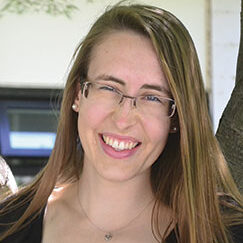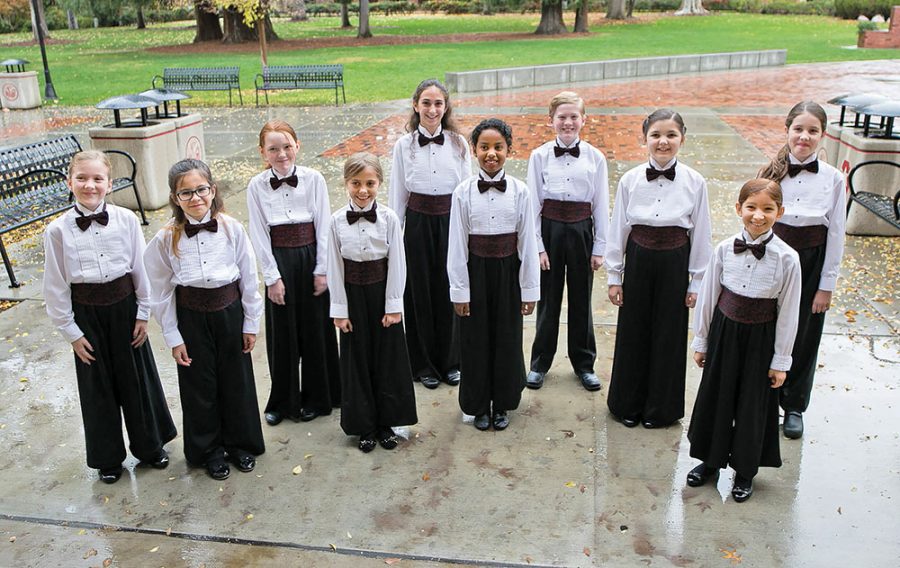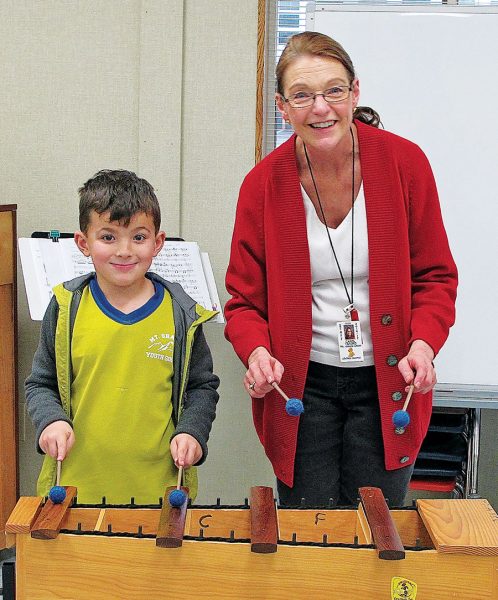

Mt. Shasta Elementary School Music Program:
When Carol Taforo’s family moved from San Leandro, California, she began volunteering as a music teacher at Mt. Shasta Elementary school where she had enrolled her young sons. “My boys loved music,” Taforo explains, “so it was important to me as a parent that they had early musical opportunities, even in a small community.”
Taforo went back to school to become a certified teacher in the Kodály method of music education, developed in the 1920-50s by Hungarian musician Zoltán Kodály. The Kodály method grounds music instruction in singing, viewing the voice as the most accessible instrument, and draws on folk music to promote a “music-literate society.”
Taforo’s students sing American folk classics about animals, trains, and coming out west. They learn tunes like “Skip to My Lou,” “This Land is Your Land,” and southern spirituals that carried slave workers through backbreaking labor. For one such song, “Pick a Bale of Cotton,” Taforo scattered cotton balls across the floor for the kids to gather as they sang, creating a sense of how singing helped slaves pace their tired bodies in the heat of the day.
Songs like this illustrate Taforo’s purpose of the program: “So much of what we do goes far beyond music,” she says. “This is kinesthetic learning about history, culture, math, social behavior and more – all through the musical door.”
The Kodály method emphasizes children’s production of their own music, so Taforo starts her students with Orff instruments, a class of wooden instrument developed specifically for teaching young children. Students also learn to keep beat and rhythm with their bodies and drums, advancing to recorder and guitar as their skills develop.
Beyond making music, Kodály’s method helps children learn to read and write music even as they learn to read and write words. Before they develop the fine motor skills needed to wield a pencil, children move notes into position on a magnetic board or stand on a music-staff floor mat in the proper position to represent a given note.
Taforo says music research indicates that while music skill-building occurs over a lifetime, musical aptitude develops before the age of 8 or 9. “Don’t wait to teach music,” Taforo says, “there’s a lot that kids can do when they’re young.”
Children’s Choir of Chico:
In 2003, two years after Susan Tevis formed the Children’s Choir of Chico (CCOC), Barbara Burkett’s daughter joined Cantiamo, a division for children in fourth grade and up. Two years later, despite the word “children” in its title, CCOC expanded to include Bella Voce, a choir for adult women. This new choir made it possible for mothers, like Burkett, to pour themselves into song.
Burkett joined Bella Voce 12 years ago and currently serves as the choir board’s president. Under Tevis’ continued direction, CCOC welcomes not only children and moms in Chico, but all children and adult women in both Butte and Glenn counties. The main prerequisite: to love singing.
The choir currently offers five divisions, largely based on age range, with tuition ranging from $43-$78 a month. The majority of the choirs accept anyone interested in developing their vocal skills. “In this age of American Idol, which picks up on natural talent, we’re a school of vocal music training. In that way, we’re kind of counter-cultural,” Burkett remarks.
Any student who spends time with the choir can learn to sight-read sheet music, sing as part of a whole, and use excellent technique to protect their vocal chords while producing their best sound. Like Carol Tafaro of Mt. Shasta Elementary, Tevis follows Kodály methods to teach singing. Younger children learn music experientially, memorizing pertinent hand signs or movements to help them internalize concepts of rhythm.
Bel Canto, a CCOC division for serious vocal students in 8th to 12th grades, does require auditions. In June, 11 Bel Canto students will travel to New Orleans for the Crescent City Choral Festival, an annual four-day event. Both before and after the festival, the choir will participate in service projects that contribute to the ongoing restoration of New Orleans, which is still recovering from Hurricane Katrina. To support this venture, Bel Canto will host several fundraisers.
Back at home in the North State, all CCOC choirs will perform in two spring concerts May 14 and 21, as well as debut “Chico Idol,” a two-part singing competition April 1 and May 7. These fundraising events, open to the public, will help keep the choirs alive and strong to carry on their music lessons. To find out more call (530) 342-2775 or visit http://www.childrenschoirofchico.org.
As Burkett says, “Singing carries physical, social and emotional benefits. Singing in a choir brings a special kind of teamwork and fellowship.” And their collective vocals do not just benefit the children of Mt. Shasta Elementary or CCOC. Using Taforo’s adjectives, children’s “light, free, pretty” voices, united as one, impart the blessing of singing to anyone listening.
Posted in: Art & Music, Community
Comment Policy: All viewpoints are welcome, but comments should remain relevant. Personal attacks, profanity, and aggressive behavior are not allowed. No spam, advertising, or promoting of products/services. Please, only use your real name and limit the amount of links submitted in your comment.
You Might Also Like...

5 Things To Do With Kids In Arcata
5 Things To Do With Kids In Arcata Summertime on the northern California coast! Beachcombing, kickin’ it at the dunes, dipping toes in the ocean with all the whales, octopi, […]
Be More Than A Hero… Be a SUPERHERO! – Join the CASA Superhero Runs in Chico and Redding
Heroes will not be hard to find in the North State this month and next: they’ll be out in the open, running for a good cause and having fun in […]
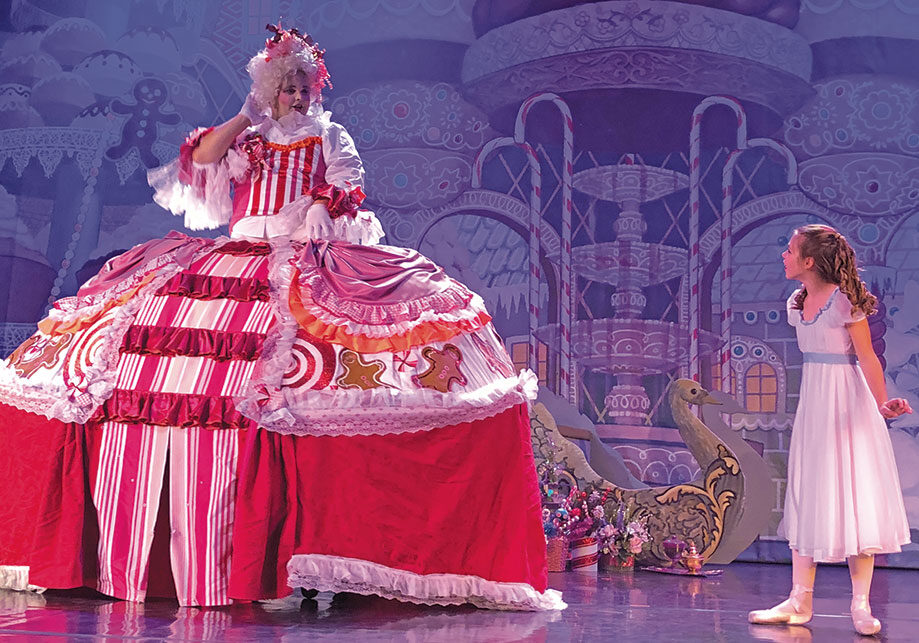
The Redding Ballet Company: The Nutcracker
The Redding Ballet Company is celebrating 20 years of “The Nutcracker” performing three shows and their school show at the Cascade Theater. From its humble beginnings in 1816 as fairy […]
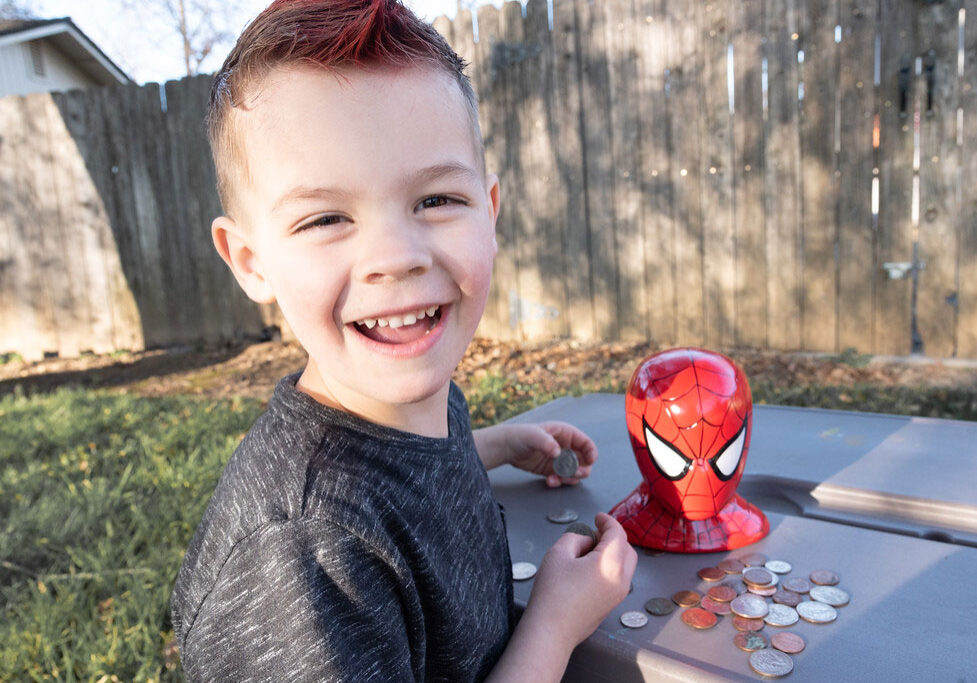
Raising Creative Kids On A Budget
In our increasingly structured and media-saturated society, kids often don’t get the time or space to be creative. Many of us think of creativity as only pertaining to the arts. […]

